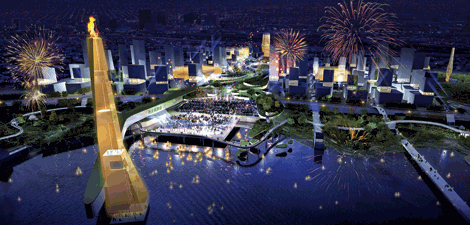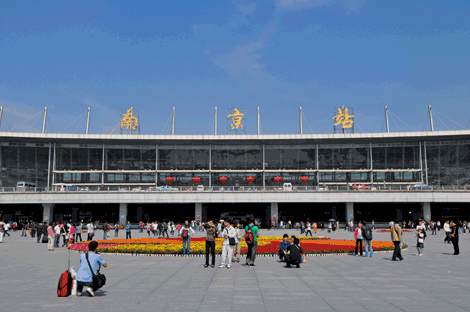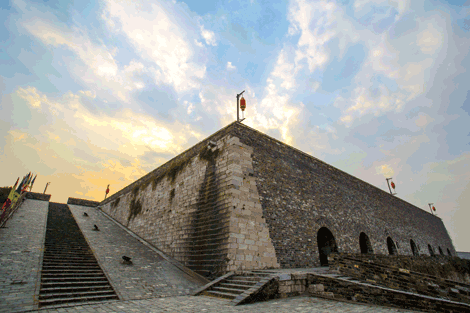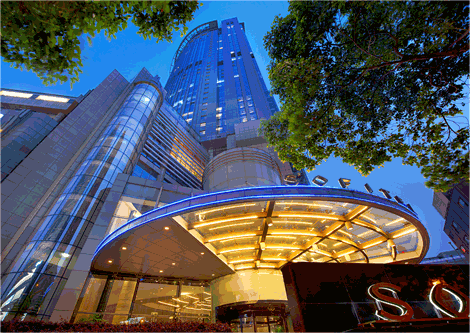China‘s capital city during the Republican period from 1911 until the government moved temporarily to Chongqing during World War II, Nanjing is today among the nation’s foremost cities of trade, commerce and tourism. The city is located on the banks of the River Yangtze – around 300 km from Shanghai – and is the capital of the prosperous Jiangsu province, as well as a strategic inland port and transportation hub.
As in many large Chinese cites, rapid urbanisation and economic growth have been fully embraced, resulting in the transformation of Nanjing’s infrastructure and skyline. Several mixed-used skyscrapers housing hotels, malls, offices and serviced residences have sprung up in recent years, the most eye-catching being Greenland Tower. Standing 450 metres tall, the world’s seventh-tallest building soars above the ancient Drum Tower just across the street.
Another recent arrival is the World Trade Centre Nanjing, which is opening in phases and, once fully completed in 2015, will comprise four landmark towers housing offices, a luxury hotel, serviced residences with sky gardens designed by Antonio Citterio, a retail plaza and the Nanjing World Trade Centre Business Club.
For visitors, Nanjing (which means “Southern Capital”) rivals Beijing (“Northern Capital”) for its intriguing spread of ancient tombs, palaces and historic monuments. Unlike today’s capital, however, Nanjing has retained and restored its statuesque old city walls, which are a major tourism attraction. To the east of the city, the forested slopes of Zijin Shan (“Purple Gold Mountain”, also known as Mount Zhongshan) shade the ancient Ming Dynasty Tombs, dating from the 15th century, plus the mausoleum of Sun Yat-sen, known as “Father of Modern China”. His impressive former Presidential Palace in the city centre now houses the China Modern History Museum.

Artist’s impression of the upcoming Summer Youth Olympics
Nanjing is also a renowned city of education, and its large student population ensures a lively and varied nightlife. The scenic Nanjing University campus in the heart of the old city was founded in 1902, and is one of China’s most respected educational institutions. The city is also preparing to host the 2nd Summer Youth Olympics on August 16-28 – the inaugural games of which were hosted in Singapore in 2010.
First Impression
International and domestic arrivals will find Nanjing Lukou International Airport to be functional, but soulless. Like many Chinese airports, it was designed with future capacity growth, rather than added-value services, in mind. Flight connections include all major Chinese cities, plus South Korea, Thailand, Malaysia, Singapore and Germany.

Nanjing South Railway Station
The fixed start fee for a taxi to the city is RMB11 (US$1.81). Domestic business travellers are increasingly turning to the punctual high-speed train network to avoid the frequent flight delays in China. Super-speedy trains from cities including Beijing, Shanghai and Hangzhou arrive at Nanjing South Railway Station, which claims to be one of the world’s largest stations – and has a greater variety of coffee shops and food outlets than the airport! The station is a short taxi ride from downtown, or a quick hop on Metro Line 1 from the station in the basement.
Orientation
Befitting its status as China’s former capital, Nanjing is a vast city with a population of more than seven million. Bordered to the west by the mighty Yangtze River, Nanjing’s 6,500 sq kms of land mass are framed to the north, east and south by the rolling hills of the Ningzheng Ridge.
The city is divided into 13 administrative districts. Business visitors tend to stay in the new hotels of downtown Xinjiekou and the adjoining Gulou district, which developed around the ancient Drum Tower and features several new commercial buildings. The fast-developing Hexi District, located between the Yangtze and Qinhuai Rivers is emerging as Nanjing’s new financial and commercial centre.
What to Do
Walk the Old City Walls

A sturdy defensive wall and two inner walls were built in the 14th century to protect Nanjing’s imperial palace. The ancient city walls have been carefully restored, and climbing the uneven steps up to Zhongshan Gate, which is a short cab ride southeast of downtown, is a good way to begin a leisurely exploration of the elevated ramparts, which yield excellent views of Nanjing‘s historic buildings, Xuanwu lake and the modern skyline.
Open to the public 8am-11pm daily.
Memorial Hall of the Nanjing Massacre
Wartime history weighs heavily on Nanjing, which was the scene of brutal atrocities committed by the invading Imperial Japanese Army. The well-curated and intensely moving Memorial Hall of the Nanjing Massacre commemorates the killing between December 1937 and February 1938 of up to an estimated 300,000 Chinese soldiers and civilians. Giant sculptures and art works, a reflective pool, and a viewing hall erected over the skeletons of massacre victims in a mass grave make this a disturbing but essential memorial to a dark period in Nanjing’s backstory.
Open 8am–5:30pm, closed on Monday. Located at 418 Shuiximen Dajie.
Free admission. Tel: +86 25 8661 2230;
Where to Eat
Shiziqiao Food Street
Ask any Nanjinger for the best place to taste local cuisine, especially freshwater fish dishes and the coveted Nanjing Duck (which is salted and roasted, and considered locally to be superior to Beijing’s more famous version), and you will be directed here. Each night, this vibrant strip of restaurants and bars pulses with atmosphere and great flavours. The courtyard-style Nanjing Dapaidang restaurant is highly recommended for its braised pork belly and marinated chicken with ginger, and can be found at 2 Shiziqiao “Lion’s Head Bridge” on the corner of Hunan Lu.
Tel: +86 25 8330 5777;
Where to Stay
Intercontinental Nanjing
Located in Greenland Tower, the 433 rooms reside between the 49th and 71st floors and afford excellent city views, as does Prime Restaurant Bar and Lounge on the 78th floor. Two Chinese restaurants specialise in Cantonese and Huaiyang cuisines, while two pillar-less ballrooms and seven function rooms cater for business events. The full-service spa is perfect for a post-work indulgence.
The Westin Nanjing
Overlooking Xuanwu Lake, The Westin Nanjing offers 234 contemporary guestrooms, all with Westin Heavenly Beds and 42-inch TVs. Three restaurants and bars includes the “Five Zen5es”, which serves local and regional Chinese cuisine, and there’s also a gym and a spa. Seven meeting spaces include the ballroom, which can host up to 450 guests.
Sofitel Galaxy Nanjing

Located in a 48-storey downtown tower, this smart business hotel offers 352 rooms, including 30 suites. Guests can dine in one of the Chinese, Italian and international restaurants, swim in a sky-lit indoor swimming pool or enjoy a leisurely game on the outdoor tennis court. Located in the nearby countryside, the hotel’s sibling property, Sofitel Zhongshan Golf Resort Nanjing, will reopen in August after a major upgrade.
Shangri-La Hotel, Nanjing
Opening in Autumn 2014, this 670-room luxury hotel is located in the Gulou District and offers scenic views of Xuanwu Lake. Dining options will include a rooftop restaurant, a Chinese restaurant and an all-day dining café. Also featured will be a health club with a 25-metre indoor pool and spa. Large meetings and banquets will be hosted in a 2,000-sqm ballroom, while several meeting rooms will cater for smaller functions.
Where to Shop
Deji Plaza
Offering six floors of premium brand names, such as Bulgari, Moschino, Dolce & Gabbana, plus Chinese boutique glass brand Liuligongfang, Deji Plaza in the heart of downtown Xinjiekou is Nanjing’s most exclusive shopping centre. It also features a cinema, an indoor ice rink and several dining venues.
Located at 18 Zhongshan Road, Xinjiekou. Tel: +86 25 8478 8888
Where to Unwind
Xuanwu Lake
Situated at the foot of Zhongshan Mountain, this scenic lake with five small islets in the centre and the adjacent Jiuhuashan Park make for a pleasant and reflective retreat away from the frenetic city beat. Boating and jogging are popular pastimes, and it’s particularly photogenic in late spring when the shoreline’s cherry trees are in full blossom. The sunsets on clear summer evenings, set against a backdrop of Nanjing’s fast-changing skyline, are truly compelling.
Sifang Art Museum
Located in parkland outside Nanjing that has been set aside as a natural space to create bold contemporary art and architecture, the museum is a dramatic piece of modern building design. Created by New York-based Steven Holl, it took more than ten years to complete and was inspired by the “deep alternating spatial mysteries of the composition of Chinese painting”. Inside is a diverse collection of Chinese and international art, and the park also features a 65-room boutique hotel designed by Liu Jiakun and Gary Chang, and a conference centre created by Arata Isozaki.
Open Wednesday to Sunday, 10am-5pm at 9 Zhenqi Road, Pukou District. Tel: +86 25 6819 0784.








